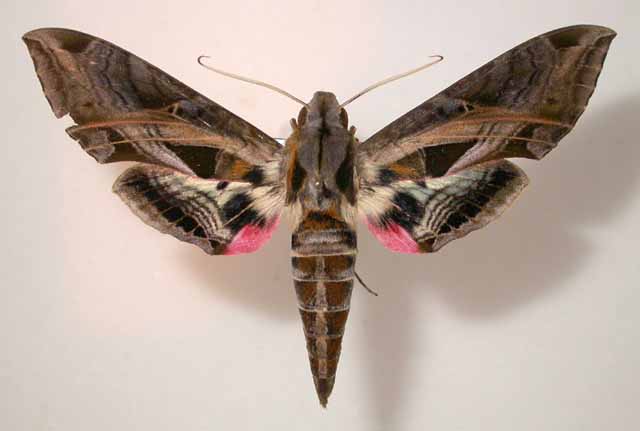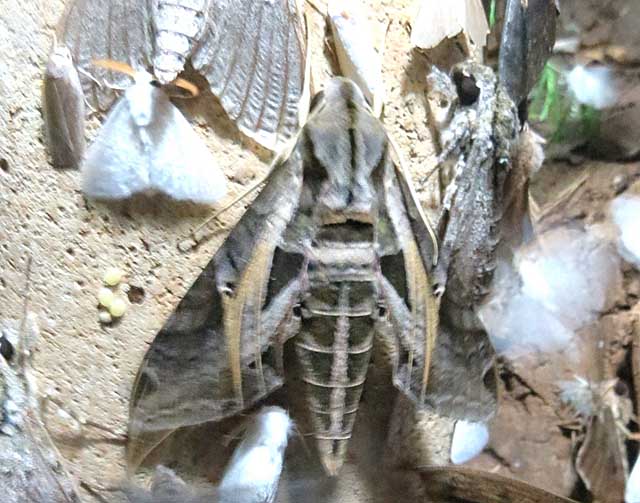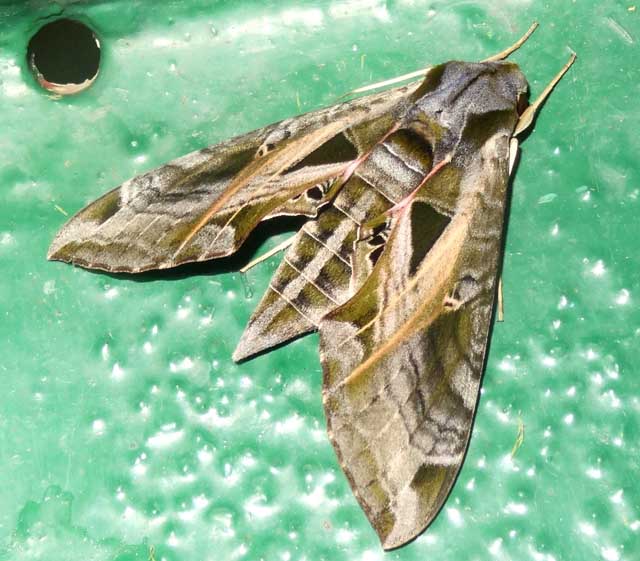Eumorpha drucei
|
|
Updated as per personal communication with Jean Haxaire
Updated as per personal communication with Brian Fletcher (Urraca Lodge, Jorupe Reserve, Loja, Ecuador, January 30, 2014, 500m); March 12, 2014
Updated as per personal communication with Tracey Woolley (Manta, Manabi, Ecuador, April 2, 2016); May 24, 2019
|
Eumorpha drucei
you-MOR-fuhMDRUCE-eye
(Rothschild & Jordan, 1903)
Pholus

Eumorpha drucei courtesy of
Jean Haxaire copyright

Eumorpha drucei, Urraca Lodge, Jorupe Reserve, Loja, Ecuador,
January 30, 2014, 500m, courtesy of Brian Fletcher, id by Bill Oehlke.
This site has been created by Bill Oehlke.
Comments, suggestions and/or additional information are welcomed by Bill.
| TAXONOMY:
Superfamily: Sphingoidea, Dyar, 1902
Family: Sphingidae, Latreille, 1802
Subfamily: Macroglossinae, Harris, 1839
Tribe: Philampelini, Burmeister
Genus: Eumorpha, Hubner, [1807]
Species: drucei, (Rothschild & Jordan, 1903) |
DISTRIBUTION:
Eumorpha drucei (forewing length: 40mm) flies in
Ecuador: Guayaquil (CATE); Loja (BF); Manta, Manabi (TW); and in
Peru (JH).
The abdomen has a pale dorsal band.
The dark, trapezoidal, olive patch midway along the inner margin is sharply pointed toward the outer margin along its upper edge.
Boldly marked, orangey veins CuA1 and CuA2 have a tawny colouration extending toward wing base in a pale, slightly arched band. The dark triangular patch near the
anal angle extends upward as far as vein CuA1.
There is a broad pink patch on the hindwing anal angle. The discal spot is black in an offwhite median area.
CATE

Eumorpha drucei, Manta, Manabi, Ecuador,
April 2, 2016, courtesy of Tracey Woolley.
FLIGHT TIMES AND PREFERRED FOOD PLANTS:
Eumorpha drucei adults are on the wing from
Eumorpha drucei larvae probably feed upon grape species.
The genus name "Eumorpha" means well-formed.
This species is name to honour Druce, who named and described many insect species. In such cases, the name is pronounced, followed by an "eye".
The pronunciation of scientific names is troublesome for many. The "suggestion" at the top of the page is
merely a suggestion. It is based on commonly accepted English pronunciation of Greek names and/or some
fairly well accepted "rules" for latinized scientific names.
The suggested pronunciations, on this page and on other pages, are primarily put forward to assist those who hear with internal ears as they read.
There are many collectors from different countries whose intonations and accents would be different.
ECLOSION, SCENTING AND MATING:
Pupae wiggle to surface just prior to eclosion. Females call at night, and males fly into the wind to pick up and track the pheromone plume.
EGGS, LARVAE AND PUPAE:
Larval Food Plants
It is hoped that this
alphabetical listing followed by the common name of the foodplant will
prove useful. The list is not exhaustive. Experimenting with closely
related foodplants is worthwhile.
Use your browser "Back" button to return to the previous page.
Return to U. S. A. Table
Return to Philampelini Index
Return to Sphingidae Index


